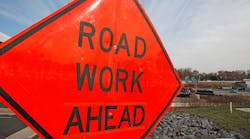Infrastructure Week started with a jolt Monday, with Department of Transportation (DOT) Secretary Elaine Chao saying initial details of the Trump administration’s $1 trillion plan will be released within weeks.
Chao suggested $200 billion from the federal government will be used to leverage $1 trillion worth of overall investment through public-private partnerships (PPPs) over 10 years.
This was not the first time Chao discussed the basic framework, but comes at a pivotal moment, with hundreds of events taking place in Washington and around the nation this week to gain support for infrastructure investments.
Sound bites on how the nation will benefit from infrastructure spending are always popular. Yet it has failed to uncover a long-term solution. The 2015 FAST Act was celebrated because it provided clarity on transportation funding until 2020, but did not address the extent of a problem created by years of inaction.
Countless times since federal fuel taxes were last raised in 1993 trucking and other industries have sought additional increases. Even when transportation leaders in Congress would use a phrase like “all options are on the table,” never was a fuel-tax hike considered a likely outcome.
Elaine Chao, back when served as Secretary of Labor under President George W. Bush.
In a Bloomberg News interview earlier this year, President Trump suggested he might be open to it. That also felt more like a sound bite than a serious agenda item likely to garner much support.
When it happened, I thought the I-35W bridge collapse in Minnesota that killed 13 people and injured 145 would bring infrastructure more into the national forefront. As we approach the 10th anniversary of that tragedy in August, it appears that was not the case.
Chao said there currently is “rare bipartisan consensus that now is the time to act” on transport funding, a common feeling during new presidential administrations.
In 2009, President Obama’s stimulus package passed along mostly partisan lines one month into his term. It provided over $100 billion for infrastructure spending, with almost half targeted for transportation.
There remains debate whether the overall plan met its goals, though few can argue with the success of the Transportation Income Generating Economy Recovery (TIGER) grants that resulted from the law.
To date, more than $5.1 billion in grants have been issued, providing a springboard for 421 major projects throughout the nation.
It remains to be seen how the Trump administration’s plan will be received. PPPs have proven controversial, with the Indiana Toll Road often referenced as a cautionary tale. It is also unclear if an infrastructure fee, suggested to the White House by trucking officials, will be included.
There is a sense that with each passing day, a honeymoon period that might allow new presidents to more easily win support is shrinking – or has already closed.
The events dominating the general news cycle will likely make the infrastructure spending pitch more challenging. If debate comes up during the third quarter, as Chao has suggested, it will take place at the same time Congress is juggling other pieces of key legislation. Many members will also be thinking about their re-election bids in 2018, and how their decisions may be used against them.Had infrastructure been a more immediate priority, it may have provided an easier opportunity for every side to claim victory - meaning a true win for the American people.
Now, however, will a funding debate devolve into how the other side’s ideas are misguided? Will it prevent hard decisions from being made?
With the needs so great and so much money at stake, some agreement will be reached. But it is hard to imagine a level of cooperation that could help craft that modern transportation vision so desperately needed.
Maybe the momentum from events like Infrastructure Week will make a difference this time around. Releasing a plan and starting a real debate would be good steps toward the goal.





